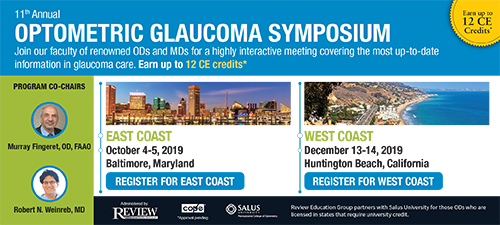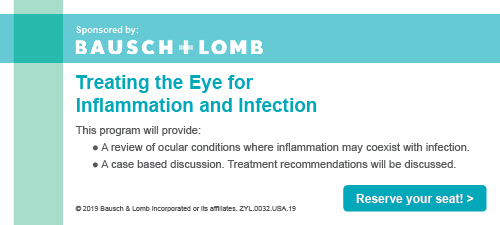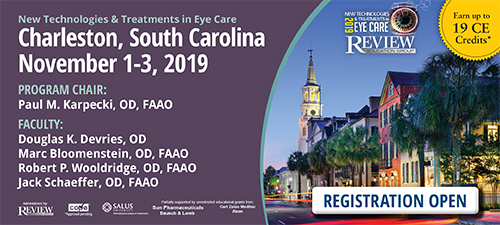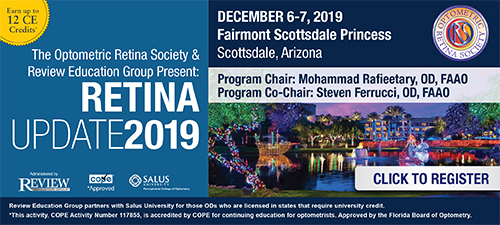
A
weekly e-journal by Art Epstein, OD, FAAO
Off the Cuff: Why Evaporative and Aqueous-deficient Dry Eye are Figments of a Limited Imagination
Not a day goes by without a patient telling me that they have dry eye. I am sure it’s the same for many of you. However, in my practice, most patients are surprised when I tell them they don’t actually have dry eye, just tears that aren’t working properly. Most of these “dry eye” sufferers make plenty of tears. Even the well-informed amongst us have got it mostly wrong. We are so brainwashed on dry eyes being dry that we have a need to attribute “dry eye” to either tear evaporation or a lack of aqueous production. While these both usually play some role, it is actually the loss of tear stability, surface protection and failure of the homeostatic mechanisms that serve to right the listing “dry eye” ship that cause most of the signs and symptoms that we and our patients attribute to dry eye.
|
|||||
 |
||
| The Impact of Uncorrected Astigmatism on Night Driving Performance | ||||
This study investigated the effect of uncorrected astigmatism on night driving performance on a closed-road circuit. Participants included 10 drivers (mean age 24.4 years ± 7 years), with low to moderate bilateral astigmatism (0.75 DC to 1.50 DC), who were regular contact lens (CL) wearers. Vision and night driving performance were assessed in a cross-over design with a toric CL and a best-sphere spherical CL. Binocular visual function measures included photopic and mesopic visual acuity (VA), contrast sensitivity (CS), mesopic motion sensitivity and glare tests (Mesotest II and Halometer). Night-time driving performance was assessed on a closed-road circuit, which included measures of sign recognition, hazard detection and avoidance, pedestrian recognition distances, lane keeping, speed and overall driving score.
Correction of astigmatism with toric CL significantly improved mesopic VA, photopic and mesopic CS, mesopic motion sensitivity and reduced glare compared with the spherical CL; there were no significant effects of visual correction type on photopic VA. Correction of astigmatism using toric CL resulted in significant improvements in night driving performance compared with driving with spherical CL, particularly for sign recognition, avoidance of low contrast hazards, increased pedestrian recognition distances and overall driving score. Correction of low to moderate levels of astigmatism had significant positive effects on night-time driving performance and related tests of visual performance. Researchers noted that these findings had important implications for optical corrections to improve the night road safety of drivers with astigmatism. |
||||
SOURCE: Black AA, Wood JM, Colorado LH, et al The impact of uncorrected astigmatism on night driving performance. Ophthalmic Physiol Opt. 2019; Aug 4. [Epub ahead of print]. |
||||
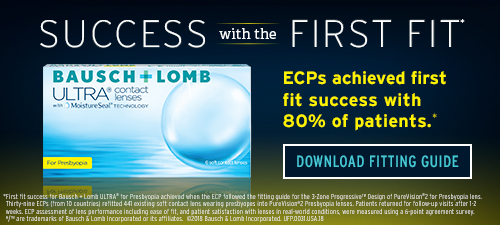 |
||
| The Prevalence of Bacteria, Fungi, Viruses and Acanthamoeba from 3,004 Cases of Keratitis, Endophthalmitis and Conjunctivitis | ||||
The definitive identification of ocular pathogens optimizes effective treatment. Although the types of ocular pathogens are known; there is less definitive information on the prevalence of causative infections including viruses, fungi and protozoa, which is the focus of this retrospective laboratory review. Data used for laboratory certification were reviewed for the detection of bacteria, viruses, fungi and protozoa from patients with infectious keratitis, endophthalmitis and conjunctivitis. The main outcome parameter was laboratory-positive ocular infection.
The distribution of infectious agents for keratitis (n=1,387) (2004 to 2018) was bacteria 72.1% (Staphylococcus aureus, 20.3%; Pseudomonas aeruginosa, 18%; Streptococcus spp., 8.5%; other gram-positives, 12.4%; and other gram-negatives, 12.9%); Herpes simplex virus, 16%; fungi 6.7%; and Acanthamoeba, 5.2%. For endophthalmitis, (n=770) (1993 to 2018), the bacterial distribution was coagulase-negative Staphylococcus, 54%; Streptococcus spp., 21%; S. aureus, 10%; other gram-positives, 8%; and gram-negatives, 7%. The distribution for conjunctivitis (n=847) (2004 to 2018) was Adenovirus, 34%; S. aureus, 25.5%, Streptococcus pneumonia, 9%, Haemophilus, 9%; other gram-negatives, 8.8%; other gram-positives, 6%; coagulase-negative Staphylococcus, 4.5%; and Chlamydia, 3.2%. The author wrote that an updated monitoring of ocular pathogens creates an awareness of the different infectious etiologies and the importance of laboratory studies. This information can determine treatment needs for infectious ocular diseases. |
||||
SOURCE: Kowalski RP, Nayyar SV, Romanowski EG, et al. The prevalence of bacteria, fungi, viruses, and acanthamoeba from 3,004 cases of keratitis, endophthalmitis, and conjunctivitis. Eye Contact Lens. 2019; Aug 1. [Epub ahead of print]. |
||||
 |
||
| The Frequency of Non-pathologically Thin Corneas in Young Healthy Adults | ||||
Measurement of normal corneal thickness and corneal epithelial thickness is important in keratorefractive surgery, glaucoma, following extended contact lens wear and in patients with corneal disease. Clinically, a central corneal thickness less than 500µm is considered to be moderately-to-extremely thin. The purpose of this study was to compare biological differences in patients with clinically thin compared to normal corneal thickness values in healthy young adults using Fourier domain optical coherence tomography. In total, 168 eyes from 84 patients ages 19 to 38 years were scanned using an Avanti optical coherence tomographer. To eliminate circadian effects on corneal thickness, all patients were scanned within a four-hour window. Corneal thickness was measured across the central 6mm of the cornea. Total central corneal thickness, corneal epithelial thickness and corneal stromal thickness were compared between males and females and tested for correlations with age, use of systemic hormones, degree of myopia and corneal curvature. The average central corneal thickness for males and females was 540.5μm ± 32μm and 525.2μm ± 33μm, respectively. Thirty-eight eyes had corneal thickness measurements below 500µm; 12% (six eyes) from males and 28% (16 eyes) from females. All women with corneas below 500μm were bilaterally thin. This finding differed for men. Corneal thinning was not associated with age, use of systemic hormones or degree of myopia. Females had steeper keratometry (K) readings than males. No differences in layer offset values between normal thickness corneas and thin corneas were evident, suggesting that the reduced thickness was not pathological. The results of this study indicated that a subpopulation of healthy young adults had non-pathologically thin corneas, well below 500μm; and that these thinner corneas were more frequent in females. Investigators wrote that their findings underscored the importance of accurate corneal thickness measurements prior to keratorefractive surgery and when evaluating intraocular pressure in glaucoma. |
||||
SOURCE: Rashdan H, Shah M, Robertson DM. The frequency of non-pathologically thin corneas in young healthy adults. Clin Ophthalmol. 2019;13:1123-35. |
||||
 |
||
| News & Notes | |||||||||||||||
| Stowe Pharmaceuticals Subsidiary to Develop Broad Spectrum Anti-Microbial Ophthalmic and Otic Therapeutics Harrow Health’s newly formed subsidiary, Stowe Pharmaceuticals, entered into an agreement with TGV Health to acquire worldwide rights to the Zian anti-microbial molecule for ophthalmic and otic uses. Zian is a patented small molecule that is water soluble, colorless and odorless, and was developed to treat various complex bacterial, fungal, and viral infections, including in the eye and ear. The initial primary indication for Stowe’s initial drug candidates is expected to be adenoviral conjunctivitis, with secondary indications for mixed bacterial-viral infections, keratitis, endophthalmitis, and corneal ulcers. In initial preclinical models, STE-006 was shown to be significantly more effective compared to current conventional therapies against numerous bacterial and viral pathogens, including strains of MRSA and herpes simplex virus. Read more.
|
|||||||||||||||
| System to Image the Human Eye Corrects for Chromatic Aberrations Researchers from the University of Washington, Seattle, reported on a new imaging system that cancels the chromatic optical aberrations present in a person’s eye, enabling a more accurate assessment of vision and eye health. By taking pictures of the eye’s smallest light-sensing cells with multiple wavelengths, the system also provides the first objective measurement of longitudinal chromatic aberrations, which could lead to new insights on their relationship to visual halos, glare and color perception, the researchers say. Read more. |
|||||||||||||||
| Kala Receives FDA Response Letter for KPI-121 0.25% NDA Kala Pharmaceuticals received a complete response letter (CRL) from the FDA regarding the company’s new drug application for KPI-121 0.25% for the temporary relief of the signs and symptoms of dry eye disease. The FDA indicated that efficacy data from an additional clinical trial would be needed to support a resubmission. Kala continues to enroll patients in its ongoing STRIDE (Short Term Relief In Dry Eye) 3 Phase III clinical trial, and expects this trial will serve as the basis of its response to the CRL. Kala is targeting topline data from the trial by the end of 2019 and resubmission of the NDA during the first half of 2020. Read more.
|
|||||||||||||||
|
|||||||||||||||
|
|||||||||||||||
|
Optometric Physician™ (OP) newsletter is owned and published by Dr. Arthur Epstein. It is distributed by the Review Group, a Division of Jobson Medical Information LLC (JMI), 11 Campus Boulevard, Newtown Square, PA 19073. HOW TO ADVERTISE |



